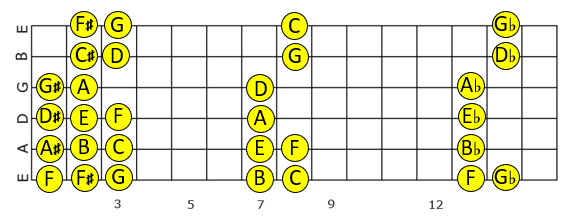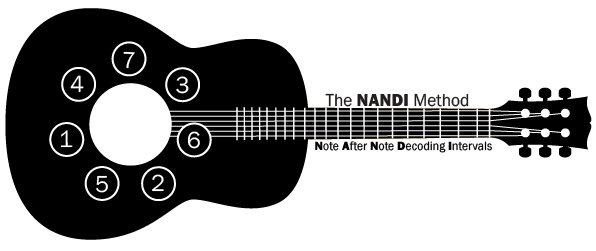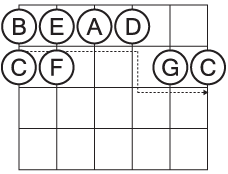Most students tend to learn the guitar fretboard by reading along the length of each string.
Unfortunately, there is very little training available for those looking to read the notes horizontally across all of the strings.
This is where The NANDI Method comes into play. The NANDI Method demonstrates how simple it is to read the fretboard without any memorization techniques. We use a simple seven-letter pattern with two variations, including sharps and flats, that are so helpful, you’ll be able to name notes within minutes!
The seven musical letters (A-B-C-D-E-F-G) are ordered in a pattern of fourths.
You will need to memorize this pattern:
B-E-A-D-G-C-F
These are the seven musical letters in the pattern of fourths.
Now what exactly do we mean by fourths?

Well, a fourth is the distance between the notes E-A-D-G. For example, if we were looking to find the number of note between E and A, we would count E, F, G, A, which is a total of four letters. B to E is also a fourth. The one exception here is when we move from G to B, which is a third. We can count a total of three letters, which are G, A, and B.
Now let’s look for the natural fourths on the fretboard

You can start with the open notes for this pattern, which are easy to identify. Let’s start by taking a look at the natural note B, which is on the open fret, followed by the natural note E. We know that we have an E on the other end too, as we have two strings that mirror one another.
You can continue on to E-A-D-G on the 6-5-4-3 strings. When you arrive at the B string, you will move one fret up to C, and then to F. F is the last note in the pattern and you have just identified all seven letters in the pattern of fourths!
Mnemonic phrases can be extremely helpful when memorizing these patterns. For this particular pattern, we will use the phrase:
Bacon Eggs and Donuts Gain Calories Fast.
B-E-A-D-G-C-F
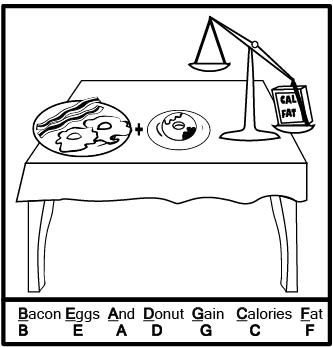
You can find this natural note pattern on the seventh fret as well.
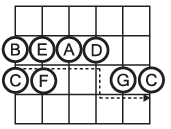
Starting with the low E string, you can move from left to right (B-E-A-D) on the same fret. You will then move from left to right to get to the G and then the C. When you have finally reached the end of the fretboard, you can move across to the other side to finish with C and F.
Flat Pattern On The Fretboard
Using the B-E-A-D-G-C-F pattern, you can come up with a pattern of flat notes, which is B♭- E♭- A♭- D♭- G♭- C♭- F♭. Let’s look at how these notes might appear on the sixth and seventh fret. Let’s first talk a bit about the last two flats.
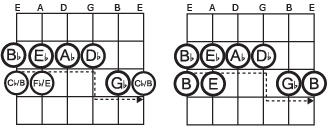
The notes C♭ and F♭ do not have an actual fret location. As you can see, C♭ is actually the note B and F♭ is actually the note E. We use these flat names due to the context of the scale.
For example, if we are in the key of C♭, the major third is E♭. The perfect fourth that is a half-step up from that is E, which means you have two notes in the scale that are named with the letter E. Of course, according to the note naming conventions, we cannot use the same letter twice in the same scale. This is the reason that we refer to the fourth scale degree of C♭ as F♭ rather than E.
When you rearrange the notes referring to C♭ and F♭ as B and E, you come up with this fourth pattern:
B♭- E♭- A♭- D♭- G♭- B- E
You must remember that the only natural note that is followed by a flat fourth is the natural note F. A fourth that is from F is B♭. We also know that B♭ is followed by four other flats. Let’s take a look at the first fret to see how they appear.
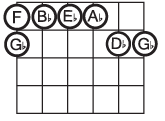
Here you see after F, you have five flats that are ordered in fourths – B♭- E♭- A♭- D♭- G♭. Because we replaced C♭ and F♭ with B and E, you can find those notes here.
Sharp Pattern On The Fretboard
You might be asking, what pattern can I use to identify sharp notes on the guitar?
If you said the B-E-A-D-G-C-F pattern, then you are absolutely correct! You can add sharps to each of these notes to get B#-E#-A#-D#-G#-C#-F#.
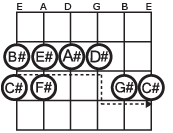
You see that B# is a fret up from B and it is followed by six other sharps. When you consider the first two notes here, we most often refer to them as C and F.
The sharp pattern puts us in a similar situation compared to the situation we were in with C♭ and F♭ in the flat pattern. B# and E# are enharmonic equivalents of C and F, B# being the major seventh in the C# major scale and E# being the major third in the C# major scale.
To apply this pattern to the fretboard, however, we must revert back to their actual names. You can see how B# and E# are replaced by C and F.
Now let’s use what we know to pull these three patterns together!
The note F at the end of the natural note pattern can be followed by five flats (B♭-E♭-A♭-D♭-G♭) and it can also be followed by five sharps (A#-D#-G#-C#-F#). F# is followed by seven natural notes (B-E-A-D-G-C-F). Take a look at the diagram below to see the entire fourth pattern at a glance.
